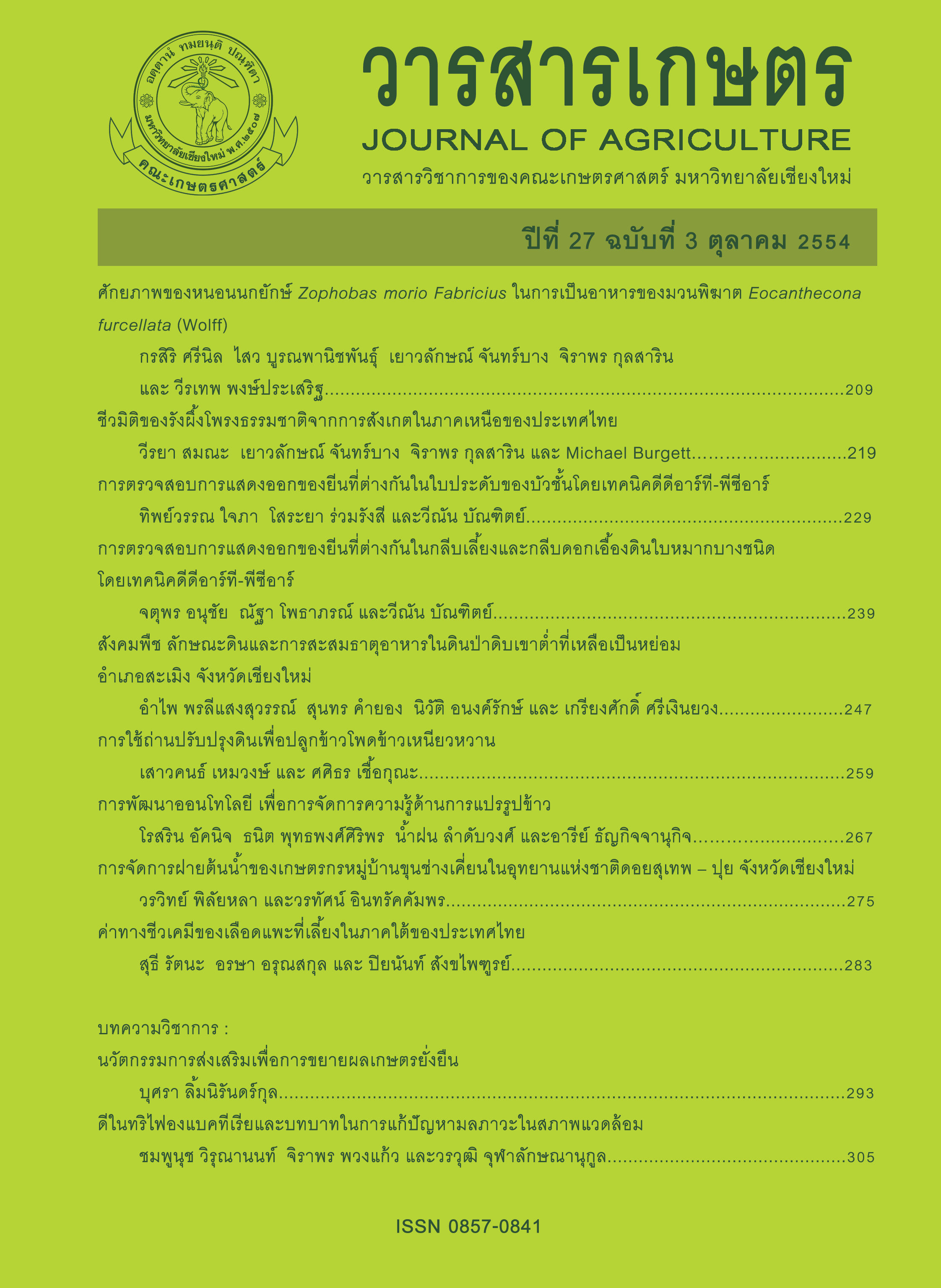การใช้ถ่านปรับปรุงดินเพื่อปลูกข้าวโพดข้าวเหนียวหวาน
Main Article Content
บทคัดย่อ
ถ่านซึ่งเป็นอินทรียวัตถุชนิดหนึ่งที่เป็นแหล่งธาตุอาหาร และช่วยเก็บกักคาร์บอนไว้ในดิน การศึกษาผลของการใส่ถ่านต่อความอุดมสมบูรณ์ของดิน การเจริญเติบโต และผลผลิตของข้าวโพด พันธุ์ดอกคูณ 49 โดยมีกรรมวิธีจำนวน 4 กรรมวิธี ได้แก่ กรรมวิธีที่ 1 ดินอย่างเดียว (กรรมวิธีควบคุม) กรรมวิธีที่ 2 ดิน+ถ่าน กรรมวิธีที่ 3 ดิน+ปุ๋ยไนโตรเจน และกรรมวิธีที่ 4 ดิน+ถ่าน+ปุ๋ยเคมี ผลการศึกษาพบว่า กรรมวิธี ดิน+ถ่าน และดิน+ถ่าน+ปุ๋ยไนโตรเจน มีความชื้นสูงกว่ากรรมวิธีดิน+ปุ๋ยไนโตรเจน และดินอย่างเดียว ดินหลังการเก็บเกี่ยวข้าวโพด พบว่า pH, Electrical Conditivity, อินทรียวัตถุในดิน และปริมาณไนโตรเจนทั้งหมดในดิน ไม่มีความแตกต่างกันทางสถิติ แต่ปริมาณไนโตรเจนทั้งหมดมีแนวโน้มที่เพิ่มขึ้นถึงแม้ว่าปริมาณอินทรียวัตถุไม่เปลี่ยนแปลงซึ่งอาจเป็นเพราะเป็นการศึกษาระยะสั้น (3 เดือน) การเปลี่ยนแปลงอินทรียวัตถุจากการใส่ถ่านลงไปต้องใช้เวลานาน การเจริญเติบโตของข้าวโพดเมื่ออายุ 60 วันหลังปลูก พบว่า ไม่มีความแตกต่างทางสถิตทั้งน้ำหนักแห้ง และปริมาณไนโตรเจนในต้นข้าวโพด อย่างไรก็ตาม น้ำหนักผลผลิตฝักสดข้าวโพดเมื่อถึงอายุเก็บเกี่ยว พบว่า มีความแตกต่างทางสถิตที่ระดับความเชื่อมั่นที่ 99 เปอร์เซ็นต์ โดยกรรมวิธี ดิน+ถ่าน ให้ผลผลิตฝักสดสูงสุด (383 กรัมต่อต้น) และกรรมวิธี ดิน+ปุ๋ยไนโตรเจน ให้ผลผลิตฝักสดต่ำสุด (148 กรัมต่อต้น) อย่างไรก็ตาม น้ำหนักแห้งต้น และซังข้าวโพดเมื่ออายุเก็บเกี่ยว พบว่า ไม่มีความแตกต่างทางสถิติ โดยกรรมวิธี ดิน+ถ่าน ให้น้ำหนักแห้งต้นข้าวโพดสูงสุด คือ 530 กรัมต่อต้น และในกรรมวิธี ดิน+ถ่าน ให้น้ำหนักแห้งซังสูงสุด (0.21 กรัมต่อต้น) โดยกรรมวิธีดิน+ถ่าน+ปุ๋ยไนโตรเจน (160 กรัมต่อต้น) ให้ผลผลิตฝักสดต่ำกว่าการใส่ถ่านเพียงอย่างเดียว อาจเนื่องมาจาก ไนโตรเจนที่ใส่ลงไปอาจถูกถ่านดูดซับไว้ และอาจค่อย ๆ ปลดปล่อยออกมาหากทำการเพาะปลูกในปีถัดไป แต่อย่างไรก็ตาม ปริมาณของถ่านที่ใช้ในการทดลองนี้มีอัตราค่อนข้างสูง คือ 5 เปอร์เซ็นต์ ของน้ำหนักดินแห้ง การศึกษาครั้งถัดไปควรทำการศึกษาผลกระทบในระยะยาวและลดอัตราการใส่ถ่านให้น้อยลง
Article Details
เอกสารอ้างอิง
Analytical Software. 2003. User's Manual. Analytical Software, Tallahassee, FL. 396 p.
Bruun, E.W. , H. Hauggaard-Nielsen, N. Ibrahim, H. Egsgaard, P. Ambus, P.A. Jensen and K. Dam-Johansen. 2011. Influence of fast pyrolysis temperature on biochar labile fraction and short-term carbon loss in a loamy soil. Biomass and Bioenergy 35: 1182-1189.
Chotikhun, A. and N. Laemsak. 2009. Effects of various carbonization temperatures for closing wood-charcoal kiln on charcoal properties. Thai J. For. 28 (2): 73-80.
Deenik, J.L., T. McClellan, G. Uehara, M.J. Antal, Jr. and S. Campbell. 2010. Charcoal volatile matter content influences plant growth and soil Nitrogen transformations. Soil Fert. Plant Nut. 74(4): 1259-1270.
Feamside, P. M., P.M. Lima, A. Graca and F.J.A. Rodrigus. 2001. Burning of Amazonian rainforests: burning efficiency and charcoal formation in forest cleared for cattle pasture near Manus, Brazil. Forest Ecol Management 146: 115-128.
Fontaine, S., G. Bardoux, L. Abbadie and A. Mariotti. 2004. Carbon input to soil may decrease soil carbon content. Ecology Letters 7(4): 314-320.
Glaser, B., L. Haumaier, G. Guggenberger and W. Zech. 2001. The 'Terra Preta' phenomenon: a model for sustainable agriculture in the humid tropics. Naturwissenschaften 88: 37-41.
Goudriaan, J. 1995. Optimization of nitrogen distribution and of leaf area index for maximum canopy assimilation rate. pp. 85-97. In: T.M. Thiyagarajan, H.F.H. ten Berge, M.C.S. Wopereis (eds.). Nitrogen Management Studies in Irrigated Rice. Los Baños, Philippines: International Rice Research Institute.
Hemwong, S., G. Cadisch, B. Toomsan, V. Limpinuntana, P. Vityakon and A. Patanothai. 2008. Dynamics of residue decomposition and N2 fixation of grain legumes upon sugarcane residue retention as an alternative to burning. Soil Till. 99: 84-97
Lehmann, J., J.P. da Silva Jr., C. Steiner, T.'Nehls, W. Zech and B. Glaser. 2003. Nutrient availability and leaching in an archaeological Anthrosol and a Ferralsol of the Central Amazon basin: fertilizer, manure and charcoal amendments. Plant Soil 249: 343-357.
Masiello, C.A. 2004. New directions in black carbon organic geochemistry. Marine Chemistry 92: 201-213.
Masulili, A., W.H. Utomo and M.S. Syechfani. 2010. Rice husk biochar for rice based cropping system in acid soil 1. The characteristics of rice husk biochar and its influence on the properties of acid sulfate soils and rice growth in West Kalimantan, Indonesia. Journal of Agricultural Science 2(1): 39-47.
Mbagwu, J.S.C. and A. Piccolo. 1997. Effects of humic substances from 149 oxidized coal on soil chemical properties and maize yield. pp 921–925. In: J. Drozd, S.S. Gonet, N. Senesi, and J. Weber (eds.). The Role of Humic Substances in the Ecosystems and in Environmental Protection. Polish Society of Humic Substances, Poland.
Panya, O. and G.W. Lovelace. 1988. Charcoal making in rural Northeast Thailand: rapid rural appraisal of a wood-based, small-scale enterprise. Research Report. KKU- FORD Rural Systems. Khon Kaen University. 81 p.
Sauerbeck, D.R. 2001. CO2 emissions and C sequestration by agriculture-perspecives and limitations. Nutr. Cycl. Agroeco. 60:253-266.
Steiner, C., W. G. Teixeira, J. Lehmann and W. Zech. 2004. Microbial response to charcoal amendments of highly weathered soils and amazonian dark earths in central Amazonia- preliminary results. pp. 195-212. In: B. Glaser and W. I. Woods (eds.). Amazonian Dark Earths: Explorations in Space and Time. Springer Verlag, Heidelberg.
Steiner, C., B. Glaser, W.G. Teixeira, J. Lehmann, W.E.H. Blum and W. Zech. 2008. Nitrogen retention and plant uptake on a highly weathered central Amazonian Ferralsol amended with compost and charcoal. J. Plant Nutr. Soil Sci. 171: 893-899.
Tryon, E.H. 1948. Effect of charcoal on certain physical, chemical and biological properties of forest soils. Ecol. Monogr. 18: 81–115.
Ueno, H., Y. Gomi, N, Asagi and T. Tsurumi. 2007. Effect of charcoal application on radish growth and N uptake estimated by 15N method. Proceedings of ASA-CSSA-SSSA., Louisiana, 4-8 November 2007. pp. 194.
Verheijen, F.G.A., S. Jeffery, A.C. Bastos, M. van der Velde and I. Diafas. 2010. Biochar Application to Soils: A Critical Scientific Review of Effects on Soil Properties, Processes and Functions. Italy: European Communities.
Warnock, D.D., J. Lehmann, T. Kuyper and M. Rillig. 2007. Mycorrhizal responses to biochar in soil- concepts and mechanisms. Plant Soil 300: 9-20.


